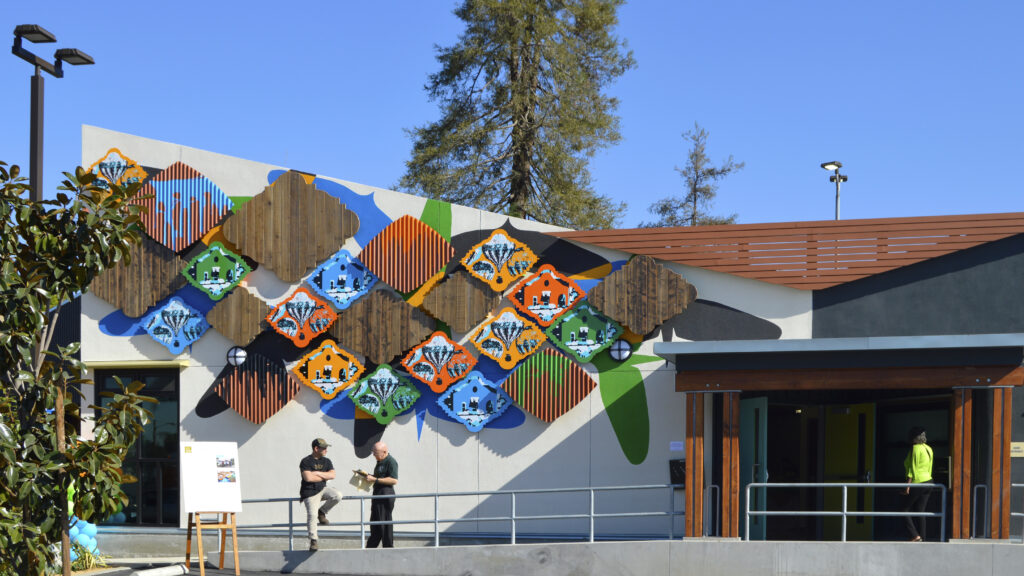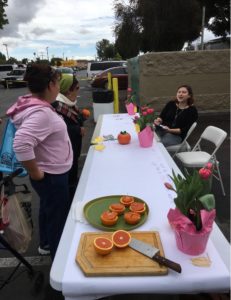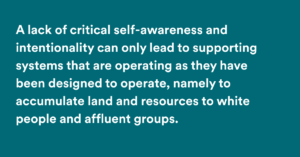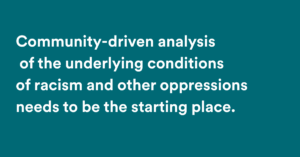Systems Check: Pushing Creative Placemaking Research into Systems Thinking
June 25, 2025
This year, a2ru will be publishing a series of open-access articles examining the legacy of ArtPlace America, which ceased operations at the end of 2020, and the continuing impact and future potential of its cross-sector research within the evolving field of creative placemaking/keeping.
Susannah Laramee Kidd, PhD
I unknowingly joined the field of creative placemaking research in 2015 when I became an embedded evaluator for the “Creative Graffiti Abatement” project, then already underway in South Los Angeles County. I was a budding applied researcher and evaluator, with a tiny bit of prior local government experience, and zero subject matter expertise in cultural policy, community development, or urban planning. I did have sophisticated qualitative research and deep listening skills, honed during a fieldwork-based PhD at the intersection of religion, literature, and gender. And I had a strong hunch that these skills would be helpful in tracing the dynamics and impacts of community-based arts and cultural strategies.[1]

“Dominguez Field and the Famous Titans of Aviation” by Fausto Fernandez at East Rancho Dominguez Park and Community Center. Photo courtesy of the Los Angeles County Department of Arts and Culture.
Evaluating Creative Placemaking Then, Through the Lens of Now
So, to develop my evaluation approach, I listened carefully to my arts colleagues who were experienced practitioners. They had their own hunches and hypotheses to test, formed during their work alongside neighbors and community institutions. The theory of change embedded in the project design was that increasing engagement prior to, during, and after the installation of artworks would increase engagement with and a sense of attachment and ownership of these civic spaces. Since I was new to the Los Angeles region as well as the field, I also spent time understanding the neighborhoods we were working with. I looked at demographics and other community-level datasets, yes, but I also listened to how residents and county staff experienced these sites. I came to understand some of the histories in each place and the current issues they were grappling with. Coming with East Coast pre-conceived notions about graffiti as primarily a form of cultural expression, I learned that many residents in South Los Angeles County neighborhoods experienced graffiti as markers of gang territory. In this case, graffiti, especially in park spaces, sent a signal about who and what activities are welcome in that public space. Other residents were not overly concerned about graffiti, since the County generally removed graffiti before anyone noticed it. These residents were more concerned about signs of general neglect and lack of investment in their public spaces.
In this context, the “Creative Graffiti Abatement” project produced physical artworks and cultural programming at two parks and two libraries.[2] In the language of ArtPlace America’s “Creative Placemaking Research” tool, the project was aimed at physical, social, and systemic outcomes from the work. To understand how these artworks and programs transformed spaces, I was watching the social layers of the artistic approaches, with an eye towards how transformed relationships to spaces might correlate to transformed ways of relating to local government and to each other. Using arts and cultural strategies, the projects were able to bridge differences between cultural groups, such as long-time Black/African-American residents and newer residents from Latinx backgrounds. All the engagement processes were aimed at facilitating collaboration between neighbors to shape the artworks in the immediate term, but also building a foundation for a more active role in shaping their public spaces together. Ultimately, these demonstration projects helped to imagine new approaches for embedding arts and cultural programming into other civic spaces at the systemic level. In the end, we decided to change the project name to “Civic Art as Infrastructure” to reflect the potential of art to enhance physical structures and spaces, as well as social and systemic processes of management and use that animate civic spaces.
To understand these outcomes, I tried to orient myself to how others were assessing the outcomes of similar kinds of projects, but I found little that captured the complexities of the social and cultural dynamics of making artistic interventions in a “place.” The socio-ecological model that I encountered in public health showed promise. As did research that pointed to collective efficacy (a.k.a. collective power) and social cohesion as strong levers for reducing crime and creating healthy communities.[3] But most indicator systems did little to capture the unintended harm in the processes and inequitable outcomes of simply adding arts and cultural strategies to traditional economic development approaches. Therefore, many attempts to come up with indicators and measurement strategies for creative placemaking were ultimately unsatisfactory.[4] In other words, these approaches were not taking into account that spaces are made into “places” by often inequitable cultural, racial, social, and economic systems.

Chatting with community members at East Rancho Dominguez Park and Community Center in South Los Angeles County. Photo: Sara Daleiden Consulting
Maturing into Systems Analysis
As a synthesis of the insights gathered across community development sectors, the “Creative Placemaking Research” interactive tool encapsulates how the field has matured in its understanding of how arts and cultural strategies can contribute to equitable community development. The inclusion of three categories of contributions in the infographic—physical, social, and systemic—indicates a necessary level of sophistication in creative placemaking research that matches the complexity of places themselves and creative placemaking practice. The representation of these categories as concentric circles is even more telling. This nested image shows us how arts and cultural strategies can and do intervene on each of these three layers at the same time, because every “place” is made up of these layers. I offered the story of the “Creative Graffiti Abatement” project above through the lens of the list of contributions as a brief illustration of how a creative placemaking strategy might operate on and be evaluated in all of three of these spheres. As a thought experiment, the vignette shows that the contributions listed in this interactive tool can reflect the strategies and potential benefits in the practice of creative placemaking.
Still, I want to take the opportunity to dig a bit deeper and assert that creative placemaking researchers and evaluators must incorporate systems thinking and analysis into our approaches to fully understand the contributions of arts and cultural strategies in the systemic sphere [5]. Hand and Sherman gesture in that direction in their “About” essay for the “Creative Placemaking Research” tool, which describes how the field of creative placemaking has caused harm because it has not been self-conscious about its role in perpetuating racism and other oppressive systems. A lack of critical self-awareness and intentionality can only lead to supporting systems that are operating as they have been designed to operate, namely to accumulate land and resources to white people and affluent groups. In system dynamics archetypes, this could be called a fix that fails, a short-term intervention in a system that ultimately reinforces the problem you are trying to change because the structure of the system is unchanged.[6] This is why early attempts to measure the outcomes of creative placemaking were ultimately insufficient. Without awareness of what it would truly look like to disrupt the systems in place, what looked like success—higher property values and quality of life metrics—only masked the system working as it was intended in the long-term—displacement and profiting from the long-term disinvestment of Black, Indigenous, and other communities of color.
 My own work as an evaluator and researcher in the field has matured as well, thankfully, and I’m growing into systems thinking and analysis as part of my toolkit that aligns with my ethnographic research orientation. I’ve learned that the first step is to understand the existing systems your strategy is trying to shift and the underlying conditions that can determine the outcomes. In a recent project assessing the potential community impact of a proposed NBA-arena on the border of Philadelphia’s historic Chinatown, we used a systems-based framework to provide a holistic assessment of Chinatown’s core identity and regional significance as a social, cultural, and economic system and to identify important areas in which disruption may result in systemwide changes.[7] Understanding how cultural value is central to Chinatown’s economy and housing market was integral to identifying where the system could be vulnerable to destabilization if the arena were built. Although it was not the focus of the study, a systems approach to understanding the core identity of Philadelphia’s Chinatown revealed opportunities for cultural preservation or creative placekeeping strategies, especially around preserving intangible cultural heritage. Granted, many creative placemaking interventions are much more tactical and do not have the resources for such in-depth analysis, but systems thinking can help us understand how individual elements of a system are contributing to the whole and how we can be strategic in pulling the levers of systems change.[8]
My own work as an evaluator and researcher in the field has matured as well, thankfully, and I’m growing into systems thinking and analysis as part of my toolkit that aligns with my ethnographic research orientation. I’ve learned that the first step is to understand the existing systems your strategy is trying to shift and the underlying conditions that can determine the outcomes. In a recent project assessing the potential community impact of a proposed NBA-arena on the border of Philadelphia’s historic Chinatown, we used a systems-based framework to provide a holistic assessment of Chinatown’s core identity and regional significance as a social, cultural, and economic system and to identify important areas in which disruption may result in systemwide changes.[7] Understanding how cultural value is central to Chinatown’s economy and housing market was integral to identifying where the system could be vulnerable to destabilization if the arena were built. Although it was not the focus of the study, a systems approach to understanding the core identity of Philadelphia’s Chinatown revealed opportunities for cultural preservation or creative placekeeping strategies, especially around preserving intangible cultural heritage. Granted, many creative placemaking interventions are much more tactical and do not have the resources for such in-depth analysis, but systems thinking can help us understand how individual elements of a system are contributing to the whole and how we can be strategic in pulling the levers of systems change.[8]
Pathways for Research into and for Disrupting the System
A crucial part of mapping a system includes understanding our place in that system. Hand and Sherman also model this critical self-reflection in their “About” essay. As an evaluator who sometimes works with public and private grantmakers, this critical self-awareness also means being critical of the role of evaluation as a tool of the nonprofit industrial complex driven by capitalist systems. For practitioners and researchers alike, systems analysis can help us be clear-eyed about the positive or negative impacts of our interventions in the ongoing legacies of racism and other oppressions. Beginning with critical systems analysis that centers our values to fight against racism and oppression and continuing to center those values in our processes of assessment and knowledge generation will be key.
While all the contributions to systems change in the “Creative Placemaking Research” diagram are promising, there are three that offer particular promise for further research into how place-based arts and cultural strategies can disrupt racist and oppressive systems, and how the research processes themselves can partner in systems change efforts. The first is by centering people and their experience of these systems. Research strategies that center the lived experiences of historically and currently marginalized communities can help us to map how oppressive systems are operating in a particular place. Qualitative research approaches like ethnography and participatory narrative inquirythat are human-centered can give us more nuanced understandings of the complexity we need to grasp [9]. Another tenet of systems thinking is that no one person can see all parts of a system. So, qualitative system modeling techniques that engage diverse groups of people to share their perspectives on a system can be extremely beneficial.
 The second is by building collective power. The “WE-making” suite of resourcesoffers a theory of change, case studies, a conceptual framework, and a literature review about how arts and culture can unite people to work together for community well-being [10]. In working with practitioners to flesh out the theory of change, it was very clear that community-driven analysis of the underlying conditions of racism and other oppressions needs to be the starting place for arts and cultural strategies to ultimately contribute to social cohesion for collective power-building as a foundation for systems change. Even so, one of the takeaways from the process of making these resources was that further research is needed to provide direct evidence of the relationship between place-based arts and cultural strategies, social cohesion, and equitable community well-being. Participatory research processes using a systems lens can also be part of bringing people together to build a shared agenda for collective action, where the people impacted by an intervention direct the intervention itself AND measure its success.
The second is by building collective power. The “WE-making” suite of resourcesoffers a theory of change, case studies, a conceptual framework, and a literature review about how arts and culture can unite people to work together for community well-being [10]. In working with practitioners to flesh out the theory of change, it was very clear that community-driven analysis of the underlying conditions of racism and other oppressions needs to be the starting place for arts and cultural strategies to ultimately contribute to social cohesion for collective power-building as a foundation for systems change. Even so, one of the takeaways from the process of making these resources was that further research is needed to provide direct evidence of the relationship between place-based arts and cultural strategies, social cohesion, and equitable community well-being. Participatory research processes using a systems lens can also be part of bringing people together to build a shared agenda for collective action, where the people impacted by an intervention direct the intervention itself AND measure its success.
Finally, there is an opportunity for further research into how creative placemaking efforts can generate new resources. In other words, we need to understand more about how place-based arts and cultural strategies can contribute efforts to push against and build something otherwise to racialized capitalism and its use of land development as a tool of extraction. The place-based systems of oppression and the scarcity mindsets around resources that they produce are deeply entrenched and complex, but the opportunity for paradigm shift here is great. As Donella Meadows argued, one of the most effective leverage points for changing a system is to shift the mindset or paradigm out of which a system arises. In order to do this, creative placemaking researchers also need to shift their paradigms, perhaps “by modeling a system, which takes you outside the system and forces you to see it whole.”[11] Place-based arts and cultural strategies themselves also have a huge role to play in highlighting the ways the economic systems are currently functioning and creating new possibilities for imagining and structuring how we share our resources.
I have barely scratched the surface in terms of understanding how place-based arts and cultural strategies—themselves part of racialized, capitalist, and settler colonialist systems—can contribute to creating systems change, but my point is that none of these are neutral. The place-based arts and cultural strategies, the research approaches, even strategies to build collective power—they are all enmeshed in racism and other oppressive systems. We need to check ourselves and where we stand in these systems, if we are going to create systems change together.
About the Author

Susannah Laramee Kidd, PhD (she/they) was born and raised in, and is happy to be based again in southern Lenapehoking/Philadelphia. She is an ethnographer turned community-engaged researcher, evaluator, and strategist, who works with artists, government agencies, arts and community development organizations, and community members to create frameworks that generate learning for social change from the ground up. Previously, they were a Mellon/ACLS Public Fellow at the Los Angeles County Department of Arts and Culture, where they evaluated public art and engagement projects at parks and libraries. You can learn more about her work at www.larameekidd.com.
Notes
[1] This was also the hunch that brought the funding for my position. I had come to the, now named, Los Angeles County Department of Arts and Culture as part of the Mellon-ACLS Public Fellows program. The program placed recent humanities and humanistic social science PhDs in public sector and nonprofit settings, with a strong belief in the relevance of advanced humanistic training for the public and nonprofit sectors.
[2] Susannah Laramee Kidd, “Art as Infrastructure: An Evaluation of Civic Art and Public Engagement in Four Communities in South Los Angeles County” (Los Angeles County Arts Commission, May 9, 2018). For the full evaluation report and documentary film materials visit https://www.lacountyarts.org/experiences/civic-art/civic-art-infrastructure/civic-art-infrastructure.
[3] For a further elaboration of how research on collective efficacy connects to place-based arts and cultural strategies, see Rachel Engh et al., “WE-Making: How Arts & Culture Unite People to Work toward Community Well-Being” (Easton, PA: Metris Arts Consulting, 2021). https://metrisarts.com/white-papers-reports/#WE-Making
[4] For more information on an attempt to validate creative placemaking outcome indicators, see Elaine Morley and Mary K. Winkler, “The Validating Arts and Livability Indicators (VALI) Study: Results and Recommendations” (Washington, DC: National Endowment for the Arts, 2014).
[5] For an introduction to systems thinking, see Donella Meadows, Thinking in Systems: A Primer, (Sustainability Institute, 2008).
[6] Daniel Kim, “Fixes that Fail: Oiling the Squeaky Wheel—Again and Again…” https://thesystemsthinker.com/fixes-that-fail-oiling-the-squeaky-wheel-again-and-again/
[7] Proposed 76ers Arena Community Impact Analysis. BJH Advisors and Sojourner Consulting for the City of Philadelphia and the Philadelphia Industrial Development Corporation, 2024. Available at phila.gov/documents/arena-proposal-impact-reports
[8] Donella Meadows, “Leverage Points: Places to Intervene in a System,” n.d., https://donellameadows.org/archives/leverage-points-places-to-intervene-in-a-system/
[9] Cynthia F. Kurtz, Working with Stories in Your Community or Organization: Participatory Narrative Inquiry, Third (Kurtz-Fernhout Publishing, 2014), https://www.workingwithstories.org/
[10] Engh et al., “WE-Making: How Arts & Culture Unite People to Work toward Community Well-Being.” https://metrisarts.com/white-papers-reports/#WE-Making
[11] Donella Meadows, “Leverage Points: Places to Intervene in a System,” n.d., https://donellameadows.org/archives/leverage-points-places-to-intervene-in-a-system/
